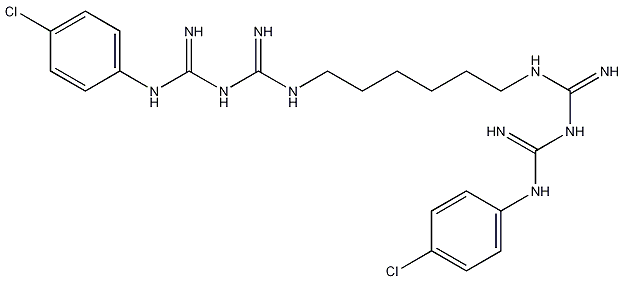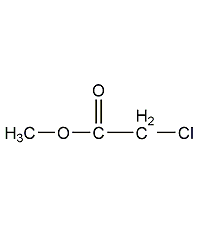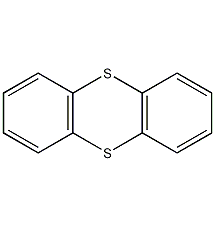
Structural formula
| Business number | 016X |
|---|---|
| Molecular formula | C22H30Cl2N10 |
| Molecular weight | 505.45 |
| label |
1,1′-Hexylbis[5-(p-chlorophenyl)biguanide], 1,1′-Hexamethylenebis[5-(4-chlorophenyl)biguanide], chlorhexidine, disinfectant, preservative |
Numbering system
CAS number:55-56-1
MDL number:MFCD00009673
EINECS number:200-238-7
RTECS number:DU1925000
BRN number:2826432
PubChem number:24854905
Physical property data
1. Properties: Colorless crystals. Sensitive to carbon dioxide.
2. Density (g/mL, 25/4?): Undetermined
3. Relative vapor density (g/mL, air=1): Undetermined
4. Melting point (ºC): 134
5. Boiling point (ºC, normal pressure): Undetermined
6. Boiling point (ºC, 5.2kPa): Undetermined
7. Refractive index: Undetermined
8. Flash point (ºC): Undetermined
9. Specific rotation (º): Undetermined
10. Autoignition point or ignition temperature (ºC): Undetermined
11. Vapor pressure (kPa, 25ºC): Undetermined
12. Saturated vapor Pressure (kPa, 60ºC): Undetermined
13. Heat of combustion (KJ/mol): Undetermined
14. Critical temperature (ºC): Undetermined
15. Critical pressure (KPa): Undetermined
16. Log value of oil-water (octanol/water) partition coefficient: Undetermined
17. Explosion upper limit (%, V/V): Undetermined
18. Lower explosion limit (%, V/V): Undetermined
19. Solubility: Dissolved in water (20°C): 0.08% , strongly alkaline.
Toxicological data
1. Skin or eye irritation: human, skin contact, standard Draize test, 1500ug/3D
2. Acute toxicity: rat oral LD50: 9200uL/kg; rat abdominal LD50: 60mg/kg ; Rat subcutaneous LD50: >1mg/kg; Mouse intravenous LC50: 21mg/kg; Mouse oral LC50: 2515 mg/kg; Mouse intraperitoneal LC50: 44mg/kg; Mouse subcutaneous LC50: 632mg/kg; Small Rat intravenous LC50: 24 mg/kg; rabbit intravenous LD: >8mg/kg3. Other multiple dose toxicity: rat oral TDLo: 150ul/kg/30D-I4, reproductive toxicity: male mouse oral TCLo: 1680mg/kg , 7 days before mating 5. Mutagenicity: mutation microorganismsTEST system: bacteria – Salmonella typhimurium: 14300pmol/plate
Ecological data
None
Molecular structure data
1, Molar refractive index: 134.02
2, Molar volume (cm3/mol): 363.3
3, Isotonic specific volume (90.2K): 999.1
4. Surface tension (dyne/cm): 57.1
5. Polarizability (10-24cm3) ?53.13
Compute chemical data
1. Reference value for hydrophobic parameter calculation (XlogP): None
2. Number of hydrogen bond donors: 6
3. Number of hydrogen bond acceptors: 2
4. Number of rotatable chemical bonds: 13
5. Number of tautomers: 36
6. Topological molecular polar surface area 178
7. Number of heavy atoms: 34
8. Surface charge: 0
9. Complexity: 649
10. Number of isotope atoms: 0
11. Determine the number of atomic stereocenters: 0
12. Uncertain number of atomic stereocenters: 0
13. Determine the number of chemical bond stereocenters: 2
14. Number of uncertain chemical bond stereocenters: 0
15. Number of covalent bond units: 1
Properties and stability
None
Storage method
This product should be stored sealed with argon gas.
Synthesis method
None
Purpose
Antiseptics, disinfectants. Medical external antibacterial agents.
extended-reading:https://www.bdmaee.net/wp-content/uploads/2022/08/Lupragen-DMI-gel-catalyst-Lupragen-DMI-epoxy-resin-curing-agent-Lupragen-DMI.pdfextended-reading:https://www.bdmaee.net/polyurethane-catalyst-9727/extended-reading:https://www.cyclohexylamine.net/cas-6425-39-4-22-dimorpholinodiethylether/extended-reading:https://www.cyclohexylamine.net/cas-3164-85-0-k-15-k-15-catalyst/extended-reading:https://www.newtopchem.com/archives/39805extended-reading:https://www.bdmaee.net/nt-cat-t96-catalyst-cas103-83-3-newtopchem/extended-reading:https://www.bdmaee.net/wp-content/uploads/2022/08/Cyclohexanamine-CAS-7003-32-9-2-methylcyclohexylamine.pdfextended-reading:https://www.bdmaee.net/fascat4233-catalyst-butyl-tin-mercaptan-arkema-pmc/extended-reading:https://www.newtopchem.com/archives/44457extended-reading:https://www.bdmaee.net/dabco-nem-niax-nem-jeffcat-nem/





